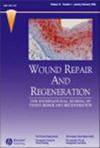Healing Profiles in Patients with a Chronic Diabetic Foot Ulcer: An Exploratory Study with Machine Learning
IF 3.8
3区 医学
Q2 CELL BIOLOGY
引用次数: 0
Abstract
Diabetic foot ulcers (DFU) are one of the most frequent and debilitating complications of diabetes. DFU wound healing is a highly complex process, resulting in significant medical, economic, and social challenges. Therefore, early identification of patients with a high-risk profile would be important to prompt adequate treatment and more successful health outcomes. This study explores risk assessment profiles for DFU healing and healing prognosis, using machine learning predictive approaches and decision trees algorithms. Patients were evaluated at baseline (T0; N = 158) and two months later (T1; N = 108) on sociodemographic, clinical, biochemical, and psychological variables. The performance evaluation of the models comprised F1-score, accuracy, precision, and recall. Only profiles with F1-score > 0.7 were selected for analysis. According to the two profiles generated for DFU healing, the most important predictive factors were illness representations on T1 IPQ-B (IPQ-B ≤ 9.5 and < 10.5) and the DFU duration (≤ 13 weeks). The two predictive models for DFU healing prognosis suggest that biochemical factors are the best predictors of a favorable healing prognosis, namely IL-6, microRNA-146a-5p, and PECAM-1 at T0, and angiopoietin-2 at T1. Illness representations at T0 (IPQ-B ≤ 39.5) also emerged as a relevant predictor for healing prognosis. Results emphasize the importance of DFU duration, illness perception, and biochemical markers to predict healing in chronic non-healing DFU. Future research is needed to confirm and test the obtained predictive models.慢性糖尿病足溃疡患者的愈合概况:机器学习探索性研究
糖尿病足溃疡(DFU)是糖尿病最常见、最令人衰弱的并发症之一。糖尿病足溃疡伤口愈合是一个非常复杂的过程,给医疗、经济和社会带来巨大挑战。因此,及早识别高风险患者对及时进行适当治疗和获得更成功的健康结果非常重要。本研究利用机器学习预测方法和决策树算法,探讨了 DFU 愈合和愈合预后的风险评估特征。在基线(T0;158 人)和两个月后(T1;108 人)对患者的社会人口学、临床、生化和心理变量进行评估。模型的性能评估包括 F1 分数、准确度、精确度和召回率。只有 F1 分数为 0.7 的资料才会被选中进行分析。根据为 DFU 愈合生成的两个特征,最重要的预测因素是 T1 IPQ-B 中的疾病表征(IPQ-B ≤ 9.5 和 <10.5)和 DFU 持续时间(≤ 13 周)。DFU愈合预后的两个预测模型表明,生化因素是愈合预后的最佳预测因子,即T0时的IL-6、microRNA-146a-5p和PECAM-1,以及T1时的血管生成素-2。T0时的疾病表征(IPQ-B≤39.5)也是预测愈合预后的相关因素。研究结果强调了DFU持续时间、疾病认知和生化指标对预测慢性不愈合DFU愈合的重要性。未来的研究需要对所获得的预测模型进行确认和测试。
本文章由计算机程序翻译,如有差异,请以英文原文为准。
求助全文
约1分钟内获得全文
求助全文
来源期刊

Wound Repair and Regeneration
医学-皮肤病学
CiteScore
5.90
自引率
3.40%
发文量
71
审稿时长
6-12 weeks
期刊介绍:
Wound Repair and Regeneration provides extensive international coverage of cellular and molecular biology, connective tissue, and biological mediator studies in the field of tissue repair and regeneration and serves a diverse audience of surgeons, plastic surgeons, dermatologists, biochemists, cell biologists, and others.
Wound Repair and Regeneration is the official journal of The Wound Healing Society, The European Tissue Repair Society, The Japanese Society for Wound Healing, and The Australian Wound Management Association.
 求助内容:
求助内容: 应助结果提醒方式:
应助结果提醒方式:


